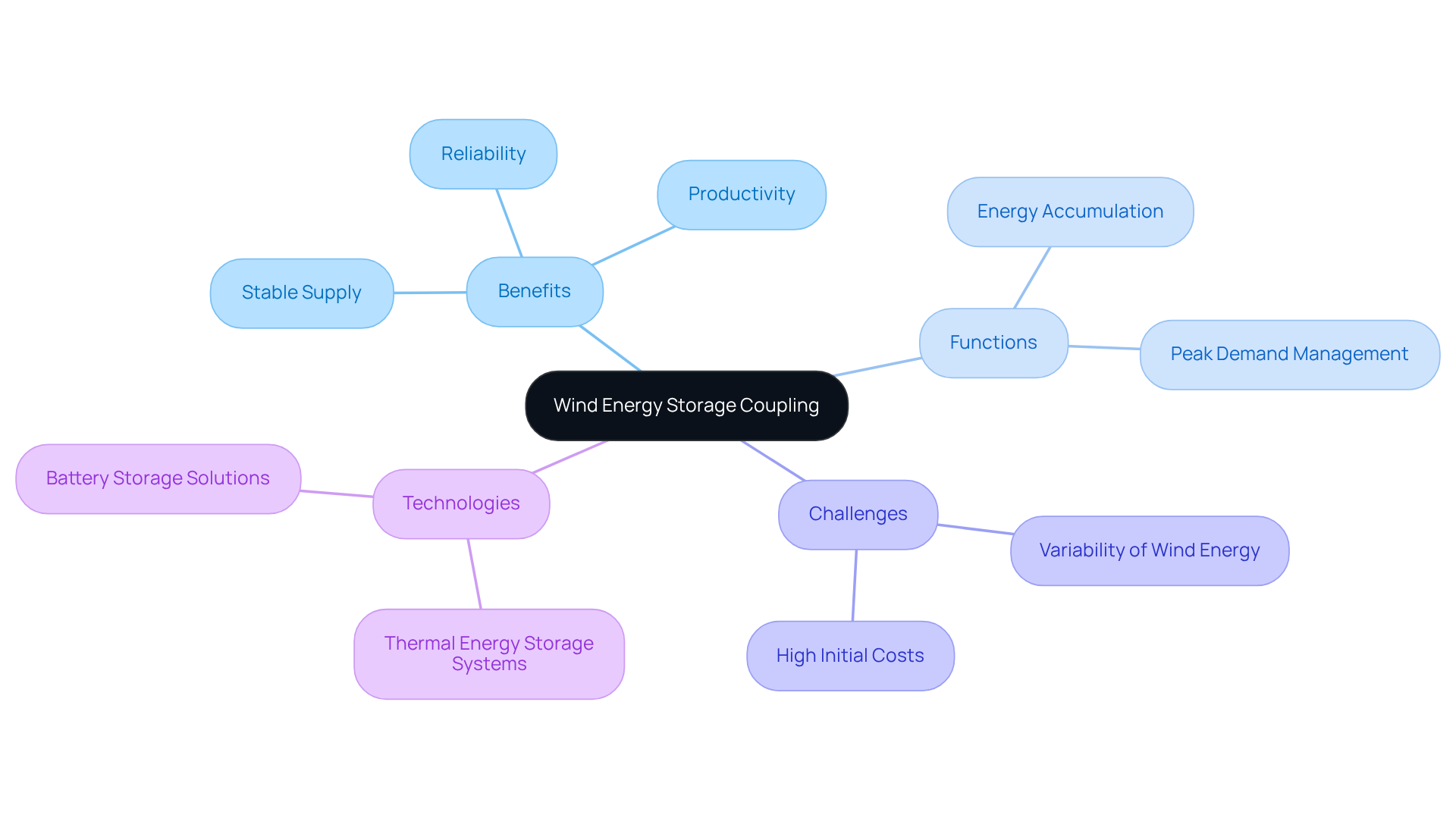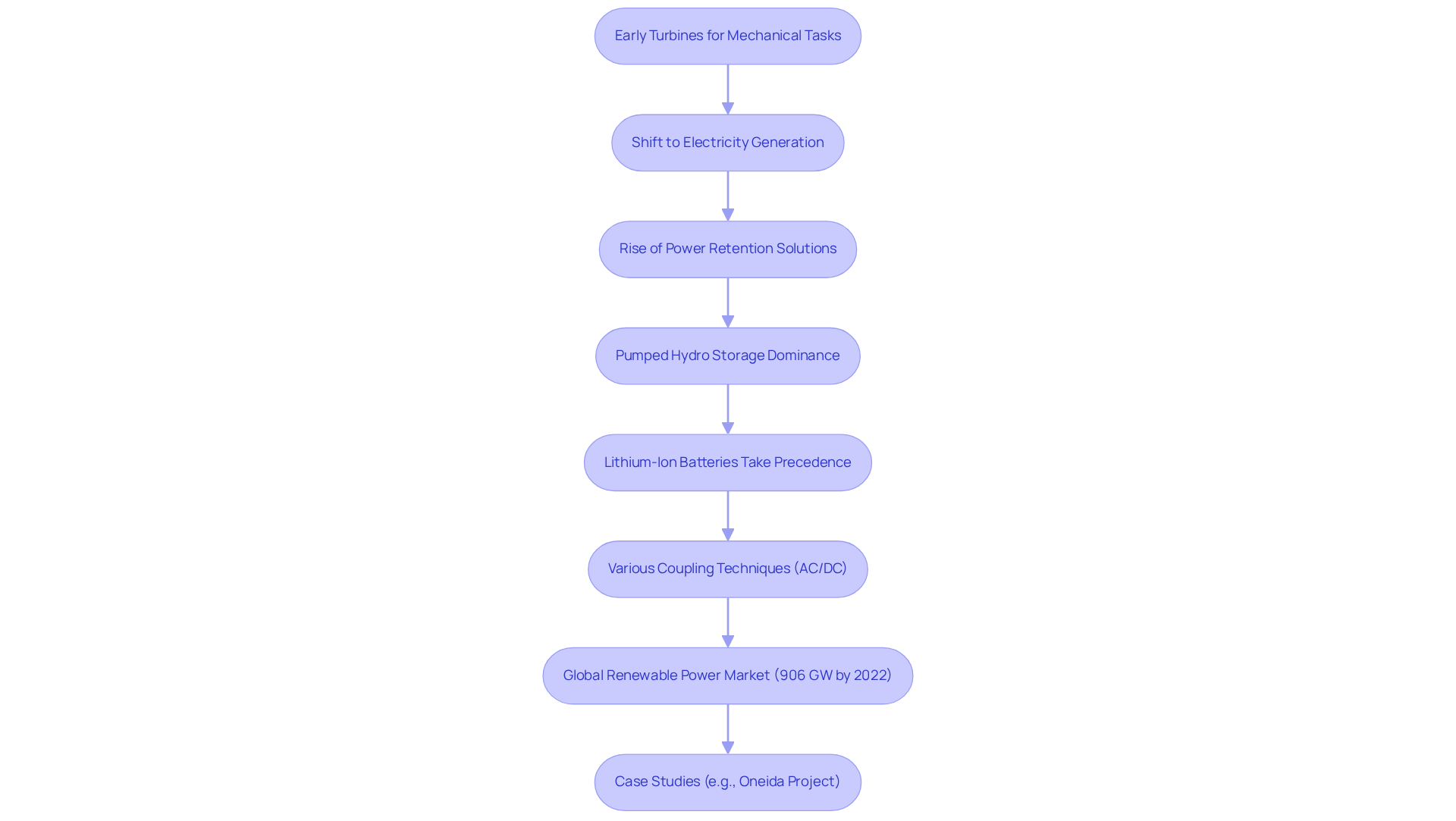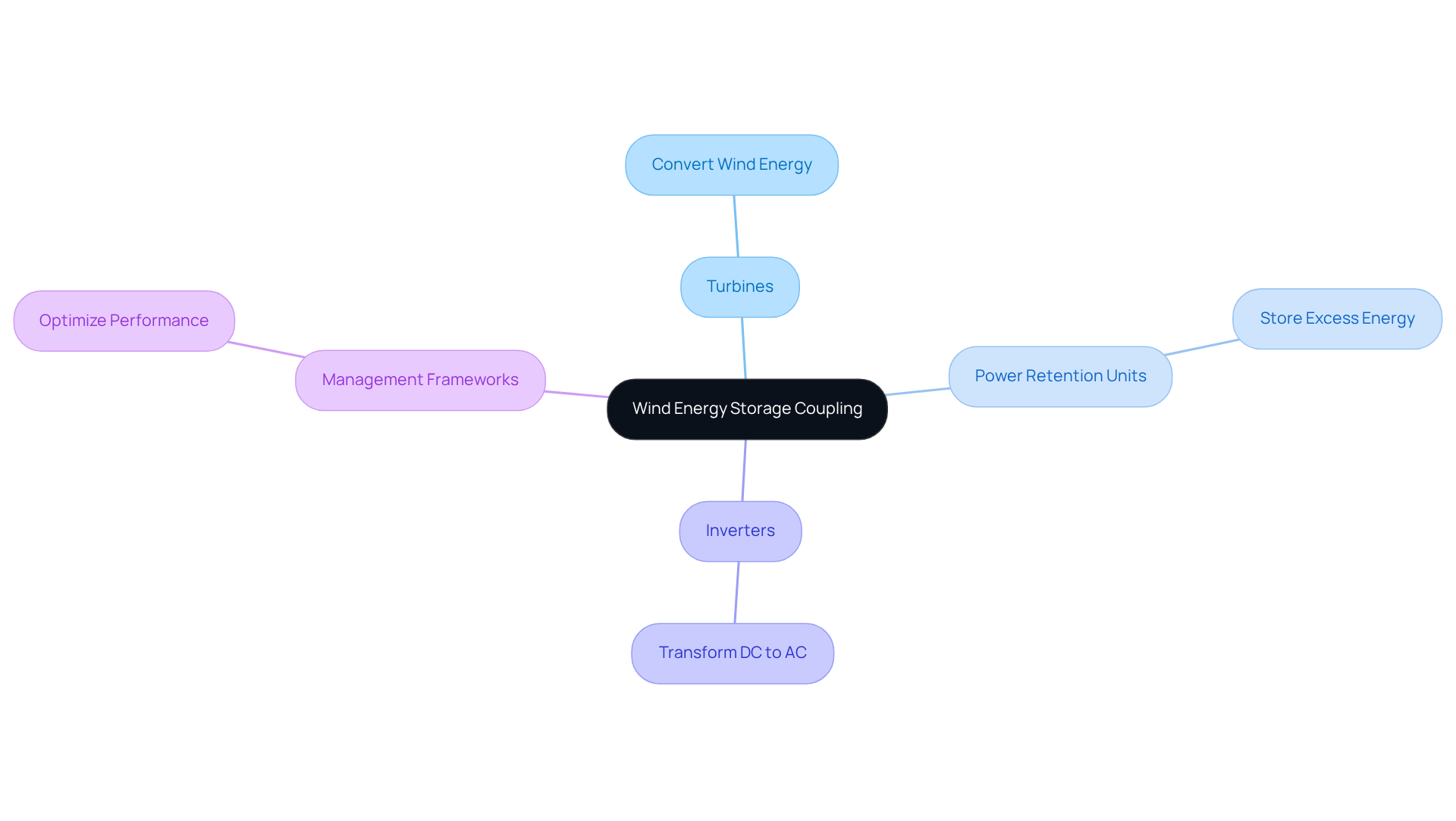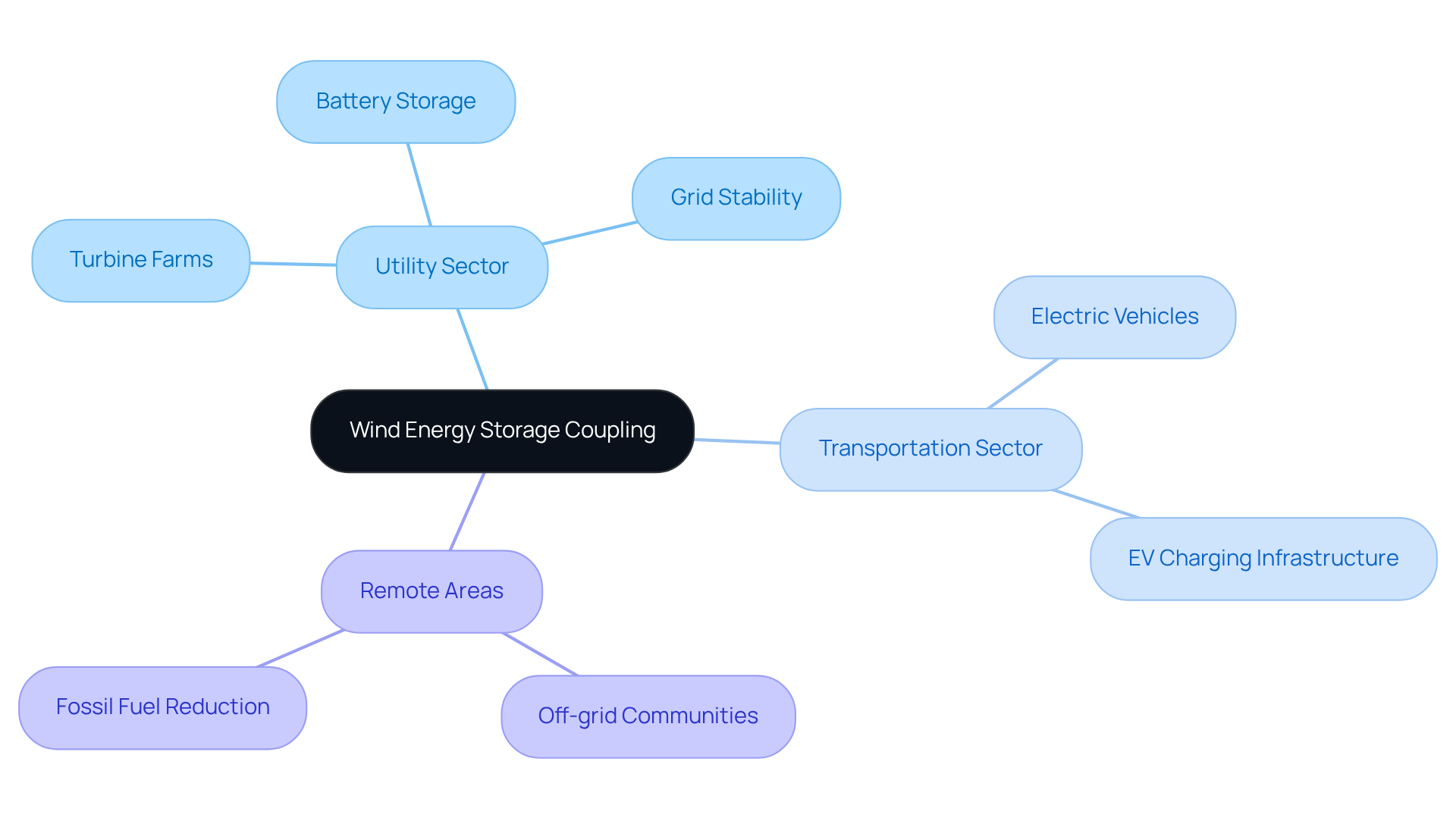Overview
Wind energy storage coupling represents a pivotal advancement in the integration of storage technologies with wind power systems. This innovative approach enhances efficiency and reliability by storing excess energy generated during high wind conditions for later use. By leveraging advancements in battery technology and strategic system components, this coupling not only stabilizes energy supply during low generation periods but also meets the increasing demand for renewable resources. The resulting benefits are substantial, encompassing both environmental and economic advantages that underscore the importance of this integration in the evolving energy landscape.
Introduction
The quest for sustainable energy solutions has never been more critical. Wind energy stands at the forefront of this movement, representing a promising avenue for innovation. Wind energy storage coupling emerges as a transformative approach, enabling the efficient capture and utilization of excess energy generated during peak wind conditions. This article delves into the intricacies of wind energy storage coupling, exploring its definition, historical evolution, and key components. However, as the renewable energy landscape evolves, what challenges must be addressed to fully harness the potential of this innovative coupling system?
Define Wind Energy Storage Coupling
The integration of renewable power accumulation pairing signifies a pivotal advancement in enhancing the efficiency of wind power generation systems through wind energy storage coupling and electricity retention technologies. This strategic wind energy storage coupling facilitates the storage of excess energy produced during robust wind conditions, allowing for its release during periods of low generation or peak demand. The primary aim is to bolster the reliability and productivity of renewable power systems, ensuring a stable supply while optimizing the use of sustainable resources. Addressing the inherent variability of wind energy storage coupling is crucial for achieving a more consistent and dependable output.

Trace the Evolution of Wind Energy Storage Coupling
The evolution of air power coupling is rooted in the early days of breeze generation, where basic turbines were employed for mechanical tasks. As technology progressed, the emphasis shifted towards electricity generation, culminating in the advent of modern wind turbines. The late 20th century saw a rise in power retention solutions, especially through wind energy storage coupling and the introduction of advanced battery technologies. Initially, pumped hydro storage dominated the landscape; however, lithium-ion batteries have since taken precedence due to their efficiency and effectiveness.
Today, various coupling techniques, including both AC and DC coupling, enhance the efficiency of turbine systems. This shift underscores a significant movement towards renewable power solutions, particularly emphasizing the role of wind energy storage coupling in addressing climate change and power security concerns. By the end of 2022, the global renewable power market reached nearly 906 GW of installed capacity, supporting over 300,000 jobs in the United States alone.
Case studies, such as the Oneida Project, exemplify the successful integration of power retention capabilities. This project, a collaboration among Northland Power, Six Nations of the Grand River Development Corporation, Aecon, and NRStor, highlights the immense potential for growth in this sector. Recent advancements in technologies related to wind energy storage coupling, including a remarkable 65% reduction in turbine costs since 2009, further reinforce this trend.
As the industry continues to evolve, the wind energy storage coupling with innovative retention solutions will be pivotal in meeting future energy demands and achieving sustainability goals.

Examine Key Components of Wind Energy Storage Coupling
The essential components of air power retention integration include:
- Turbines
- Power retention units
- Inverters
- Management frameworks
Windmills effectively convert kinetic energy from the wind into electrical power. Power retention solutions, such as batteries, pumped hydro, or compressed air systems, are examples of wind energy storage coupling that store excess energy generated during peak wind conditions. Inverters are crucial for transforming the direct current (DC) produced by turbines into alternating current (AC), ensuring compatibility with the grid. Control mechanisms oversee the transfer of energy between turbines and storage units, optimizing performance and efficiency. Collectively, these elements create a cohesive system that enhances the reliability and efficiency of renewable energy generation.

Explore Applications of Wind Energy Storage Coupling
The importance of wind energy storage coupling is evident across various sectors, particularly in enhancing grid stability and supporting electric vehicle (EV) infrastructure. In the utility sector, turbine farms paired with battery storage systems can deliver power during low airflow periods, effectively providing backup energy during peak demand. This capability is crucial, as wind energy can power over 46 million American homes, making it a significant contributor to the electricity grid. The capacity factor for turbine power stands at approximately 38%, underscoring its reliability and efficiency in power generation.
In the transportation sector, electric vehicles function as mobile power reserves, facilitating the connection of wind-generated energy with EV charging stations. This innovative approach not only optimizes resource utilization but also addresses the growing demand for sustainable transportation solutions. For instance, integrating turbine power reserves within charging infrastructure can enhance the reliability of electric vehicle charging, particularly in regions abundant in renewable resources.
Moreover, in remote areas, turbine-based power systems offer a reliable electricity source for off-grid communities, significantly reducing their dependence on fossil fuels. Wind power contributes to preventing emissions equivalent to 61 million vehicles annually, highlighting its environmental benefits. The comprehensive integration of wind energy storage coupling and retention technologies is essential for advancing renewable resource adoption, supporting sustainability goals, and stabilizing the grid amid increasing energy demands. Furthermore, the wind industry has attracted nearly $330 billion in investment over the past two decades, creating over 300,000 American jobs, which emphasizes the economic importance of wind energy storage and its potential for growth.

Conclusion
The integration of wind energy storage coupling marks a pivotal advancement in the optimization of renewable energy systems, particularly in bolstering the reliability and efficiency of wind power generation. By adeptly storing excess energy produced during peak wind conditions and releasing it during low generation periods, this strategy guarantees a stable and consistent energy supply—an essential requirement for meeting the escalating energy demands.
In the exploration of wind energy storage coupling, critical insights have emerged regarding its evolution, essential components, and diverse applications. The historical development of this technology underscores a significant transition from basic mechanical turbines to sophisticated systems leveraging lithium-ion batteries and other innovative storage solutions. Moreover, examining components such as turbines, inverters, and management frameworks reveals how they collectively foster a cohesive and efficient energy system. Applications across various sectors, including grid stability and electric vehicle infrastructure, highlight the tangible benefits of this technology in practical scenarios.
Embracing wind energy storage coupling transcends mere technical advancement; it represents a crucial step toward achieving sustainability goals and addressing climate change. The potential for economic growth, job creation, and environmental benefits renders this integration imperative for future energy strategies. As the global focus pivots toward renewable resources, sustained investment and innovation in wind energy storage coupling will be instrumental in shaping a cleaner, more sustainable energy landscape.
Frequently Asked Questions
What is wind energy storage coupling?
Wind energy storage coupling refers to the integration of technologies that enhance the efficiency of wind power generation systems by allowing for the storage of excess energy produced during strong wind conditions. This stored energy can be released during times of low generation or peak demand.
What is the primary aim of wind energy storage coupling?
The primary aim of wind energy storage coupling is to improve the reliability and productivity of renewable power systems, ensuring a stable energy supply while optimizing the use of sustainable resources.
Why is addressing variability important in wind energy storage coupling?
Addressing the inherent variability of wind energy storage coupling is crucial for achieving a more consistent and dependable output from wind energy systems.
List of Sources
- Define Wind Energy Storage Coupling
- Storing wind energy I ENERGYNEST (https://energy-nest.com/storing-wind-energy)
- Wind Power Couplings Market Report | Global Forecast From 2025 To 2033 (https://dataintelo.com/report/global-wind-power-couplings-market)
- NEWS RELEASE: New 2023 data shows 11.2% growth for wind, solar & energy storage - Canadian Renewable Energy Association (https://renewablesassociation.ca/news-release-new-2023-data-shows-11-2-growth-for-wind-solar-energy-storage)
- The impact of energy storage on the reliability of wind and solar power in New England - PMC (https://pmc.ncbi.nlm.nih.gov/articles/PMC10955263)
- Trace the Evolution of Wind Energy Storage Coupling
- NEWS RELEASE: New 2023 data shows 11.2% growth for wind, solar & energy storage - Canadian Renewable Energy Association (https://renewablesassociation.ca/news-release-new-2023-data-shows-11-2-growth-for-wind-solar-energy-storage)
- Installed wind energy capacity (https://ourworldindata.org/grapher/cumulative-installed-wind-energy-capacity-gigawatts)
- By the Numbers - Canadian Renewable Energy Association (https://renewablesassociation.ca/by-the-numbers)
- Wind Energy Market Expansion: Growth, Capacity, and Investment Stats (https://patentpc.com/blog/wind-energy-market-expansion-growth-capacity-and-investment-stats)
- Wind Power Facts and Statistics | ACP (https://cleanpower.org/facts/wind-power)
- Examine Key Components of Wind Energy Storage Coupling
- Wind - IEA (https://iea.org/energy-system/renewables/wind)
- Electricity generation from wind - U.S. Energy Information Administration (EIA) (https://eia.gov/energyexplained/wind/electricity-generation-from-wind.php)
- Energy Storage Systems for Wind Turbines💨 - Ampowr (https://ampowr.com/energy-storage-systems-wind-turbines)
- Electricity generation, capacity, and sales in the United States - U.S. Energy Information Administration (EIA) (https://eia.gov/energyexplained/electricity/electricity-in-the-us-generation-capacity-and-sales.php)
- Trends in performance factors of wind energy facilities - Discover Applied Sciences (https://link.springer.com/article/10.1007/s42452-020-03526-z)
- Explore Applications of Wind Energy Storage Coupling
- Wind Power Facts and Statistics | ACP (https://cleanpower.org/facts/wind-power)
- (PDF) A Comprehensive Review of Wind Power Integration and Energy Storage Technologies for Modern Grid Frequency Regulation (https://researchgate.net/publication/380363355_A_Comprehensive_Review_of_Wind_Power_Integration_and_Energy_Storage_Technologies_for_Modern_Grid_Frequency_Regulation)
- An overview of application-oriented multifunctional large-scale stationary battery and hydrogen hybrid energy storage system (https://sciencedirect.com/science/article/pii/S2772970224000014)
- The impact of energy storage on the reliability of wind and solar power in New England - PMC (https://pmc.ncbi.nlm.nih.gov/articles/PMC10955263)




